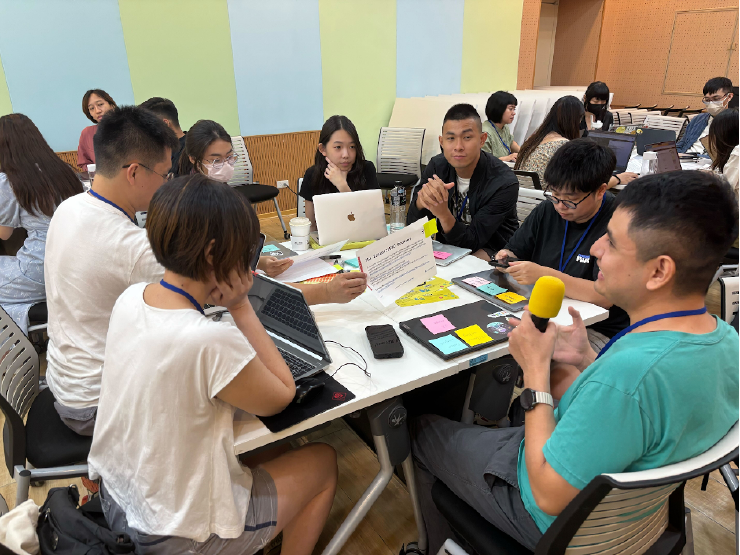
Introduction
At COSCUP 2023, we held a workshop “The Design We Open - Network Disruption Hackathon” (The Design We Open Workshop - 網路中斷黑客松), a workshop focused on how we - as designers and configurers of technology for human rights needs - can better understand Taiwanese citizens. Read the 2023 blog here.
COSCUP is a large, international conference for open source coders, users and promoters. COSCUP has a large Taiwanese, East-Asian and South-East Asian attendance base and is growing, which demonstrates how critical the event is to the wider OSS ecosystem and the OSS decentering of conversations from western Europe and the United States.
In 2024 we returned to COSCUP to hold another workshop focussed on designers making a contribution to an OSS project: “Designers in Tech-Open Source Design Workshop”, and you can find the open whiteboard canvas hosted on the Superbloom Miro account here.
Workshop aims
The workshop brought together participants from diverse backgrounds to collaboratively address issues in civic tech, privacy, security, and human rights-focused OSS tools. Attendees were primarily designers, but also developers, product managers and document writers. Superbloom selected OSS projects from previous projects, and those with Taiwan-specific civic challenges. The Superbloom team ensured that the OSS projects it reached out to were able to actively participate before, during and after the workshop. The team supported the projects in detecting potential tasks in the projects’ public code repositories (where tasks and progress is tracked by most OSS projects) and initiated discussion using these suggestions. The OSS projects were then able to add additional information, resources and additional or alternative challenges for the designers to work on during the workshop.
The workshop was structured to ensure that participants - especially those new to OSS contributions - could effectively engage and make design contributions. It featured a series of guided activities and exercises, focusing on understanding the OSS tasks, and digesting user research and usability needs identified in existing OSS projects. The Superbloom staff and volunteers provided experience in design, UI/UX and product management in OSS, and supported participants and guided them when requested.
Key objectives of the workshop
The workshop’s key objectives included:
- Demystifying non-code contributions: Educating participants about how to translate developer issues into design briefs and make meaningful design contributions to OSS projects.
- Facilitating hands-on contributions: Ensuring each participant, as part of a larger group, makes a tangible design contribution to an OSS project by the end of the workshop.
- Promoting ongoing engagement: Providing resources and documentation to encourage continued contributions from designers to OSS projects post-workshop.
- Adding value: Ensuring the design has a valued and prominent place in the configuring, discussion and building of open source technology globally and is not overlooked as an essential part of the process of meaningful and citizen relevant technology.
Preparing for a design contribution workshop
We wanted to offer a different kind of workshop to that we offered back in 2023. The 2023 “Network Disruption Hackathon” for designers was well received and enjoyed by participants and had a focus on vital OSS technologies that help people in internet shutdown and internet censorship situations. However, this workshop had a lower impact on the OSS projects and a higher impact on the designers and citizens in terms of access to new knowledge and OSS tools. In 2024, we wanted to ensure tangible design contributions to selected OSS.
With this focus, we built the workshop activities around four key pillars:
- Understanding the roles and responsibilities in OSS and the skills and expertise designers can offer OSS.
- Deep user research examples to inform and speed up the knowledge gap that the designers may have of users of censorship circumvention, privacy and security OSS tools.
- Understanding and translating issues (tasks or needs) typically written by coders and OSS maintainers in “OSS coder language” and extrapolating the design to understand the need from these.
- Providing optional templates for design contributions to these issues. From high threat anti-persona exploration and empathy maps to heuristic evaluation breakdowns and user testing script templates.
These four pillars all focussed on the ultimate (and challenging) goal of making a design contribution during the course of a single day hackathon.
In preparation for the event we explored many of the OSS projects that Superbloom has previously been involved with as well as OSS projects that are Taiwan-native and grown.
We wanted to ensure these OSS projects had a clear set of criteria including:
- Open and welcoming of design and design contributions during and after the ‘Designers in Tech-Open Source Design Workshop’. (Two developers from two different OSS projects even attended to give on-site support!)
- Reasonably easy to understand issues/tasks accessible from a public location that designers with limited knowledge of the OSS could make first contributions to.
- Reasonably easy to understand and present a system of documentation and/or clear explanation of the OSS intended purpose and user base.
A bonus criteria was that each of these tools were familiar to Superbloom workshop team members, either via previous work completed by Superbloom on the tools or through previous voluntary contributions.
Workshop activities and differences from 2023
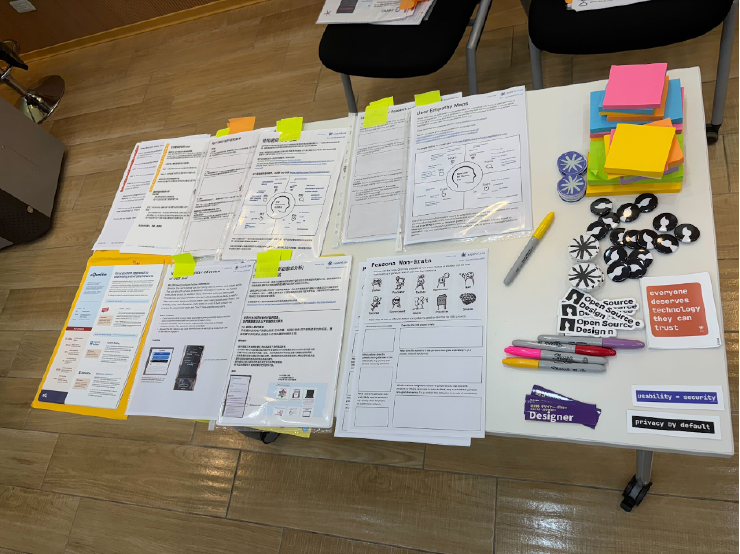
Introductions and ice breaker
This workshop began with brief introductions and agenda setting and we launched into our first active session which also served as an icebreaker exercise.


The goal of this exercise was to share skills with others in the room with a focus on what skill you want to teach others, what skill you feel confident offering as a contribution to OSS, and what skill you want to learn more about. Attendees could learn about the skills of those in the room, and as we requested people gather in groups of 5-7, they could also self-assign skill sets per group if they wished.
Forming groups and learning about each other’s skills
After groups were formed, the additional meaning of this exercise was revealed. In OSS nobody in the OSS project would know what it was possible a team member could do, wanted to do and wanted to learn more about unless those skills are clearly communicated. Design is generally an under-served skill in OSS and it’s even more important for designers to be familiar and be comfortable with describing their skills and what they want to contribute and why. This benefits the OSS ecosystem’s knowledge base of design, designers, and the skills that designers bring.
Once everyone had settled into groups we moved onto core preparation exercises, the first being a deep review of user research prepared by Superbloom, and based on our expertise and previous user research insight into the world of OSS, privacy, security and mis/disinformation.
Talking about the tools
Both Superbloom and the OSS maintainers prepared User Personas, User Journeys and User Scenarios, and offered spoken insight into the use and purpose of the OSS tools. Ceno and Co-facts team members who were present on-site talked about their tech solutions and provided detailed information about their work.
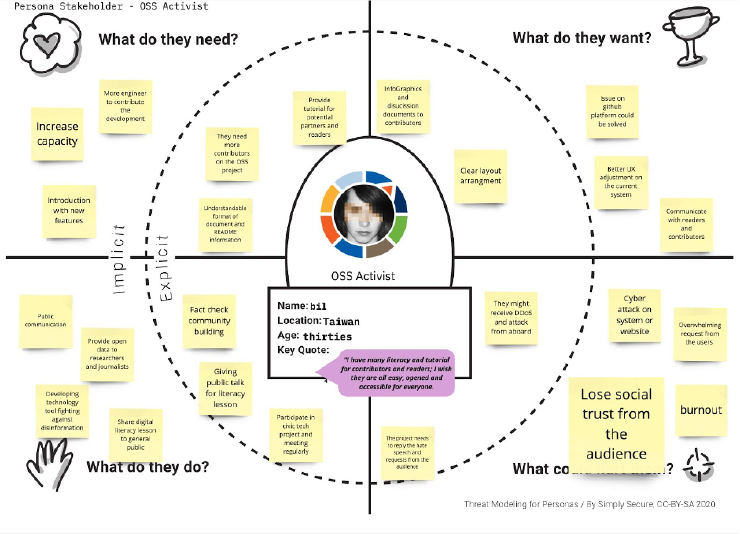
After spending time digesting this information and discussions in groups, we moved onto the next core preparation exercise, looking at the available issues and using a guiding template to translate the issues from a “developer/coder” focused issue to a “designer/user” focused issue.
The template takes the groups through a few key questions such as “Please describe the problem from at least one “user’s” point of view” and “What is success for our user/s?”. Issues in OSS that are written from “coder” or “engineering” perspectives are often technical solutions focused on how they are written, and rarely explore or mention what broad and researched user expectations, needs and success mean. This is where designers, using their background, user insight and deduction skills can begin to contribute immense value to OSS.
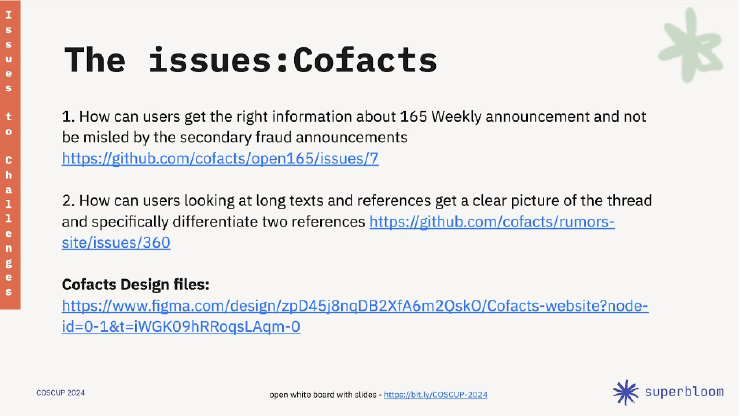
Participants picked the issues they wanted to work on
The groups spent time with six different issues across three different OSS projects and came to a group decision about which one they wanted to tackle in the remaining time. We ended up with at least one team focussing on each OSS project across different “scales” of problem. These ranged from helping make user interface elements clearer and informative to making sure users can make well-informed settings choices for their privacy and security needs.
Hands-on time, making design contributions
After making their choices, the groups moved onto the main section of the workshop about their design contributions to these issues. Superbloom prepared a number of different templates for contributions should workshop attendees struggle to find a format they wished to contribute to, or if they wished to divide up a number of connected contributions to the same issue.
These templates were:
- A persona non-grata (or adversarial personas) template. An exercise that helps OSS tools understand how a tool, feature or situation can be used maliciously by a particular kind of user with bad intentions.
- Two heuristic analysis / UX review of OSS tool statements. This is a way for tool teams and designers to locate usability and design issues within an interface. Heuristics act as guidelines or ideals toward which we hope all interfaces can strive that make systems safe and easy to use.
- User Empathy maps. These maps help an OSS project better understand the motivations and drives of users generally or in specific scenarios.
- User Testing/User Research script primer. This helps the designer and OSS project begin to lay out how they can user test a particular feature or aspect of the functionality of their OSS.
You can find the templates in our open repository here.
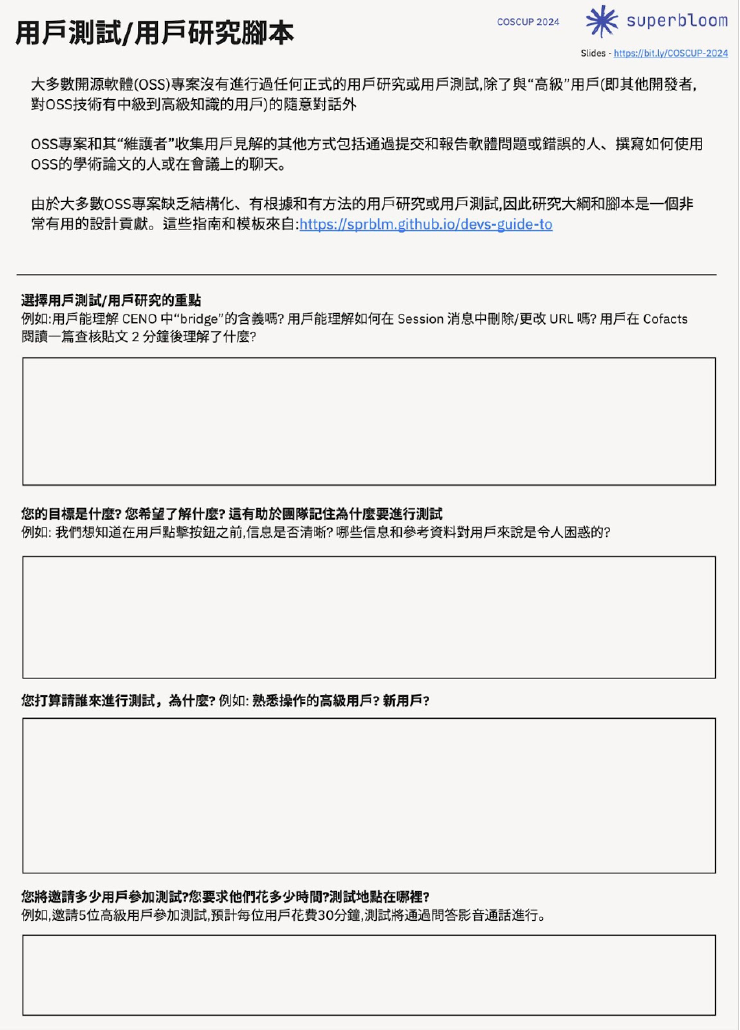
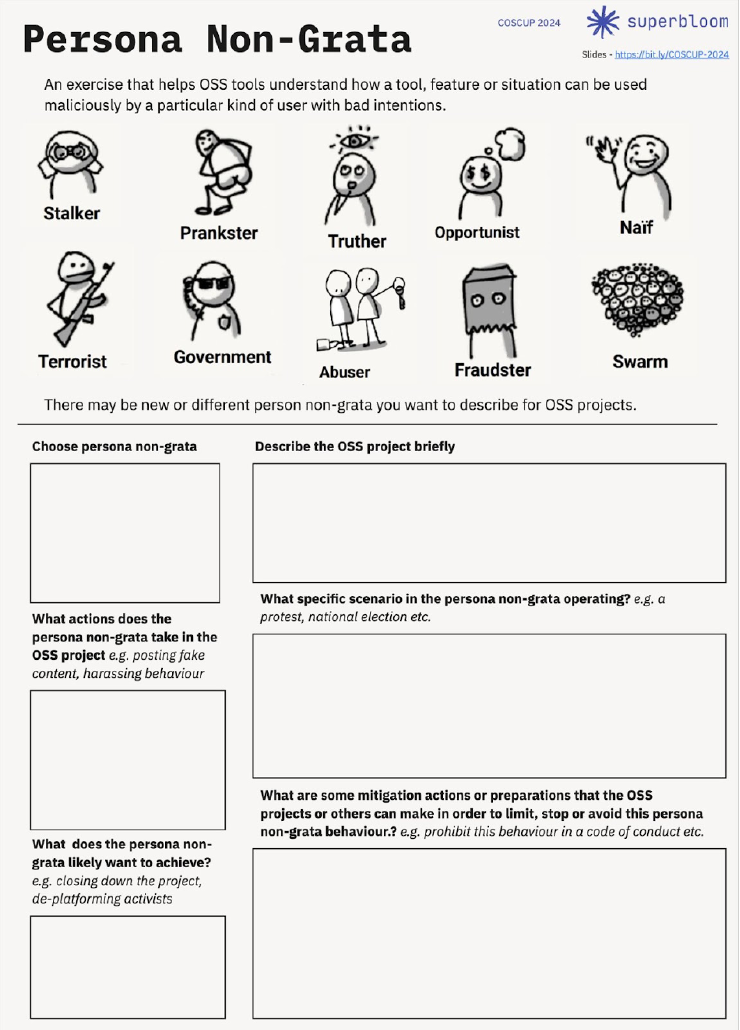
The teams then had two and half hours to make their contribution and submit them to the OSS projects to issue before the end of the workshop.
All teams made their contributions before the end of the workshop, and you can see the results here:
- For Cofacts 165 reporting spam in Taiwan issue
- For Ceno to ensure users understand know about privacy and consent
- For Session to ensure users understand when messages and media have been shared from a private message thread
Translations to Mandarin and open resources
All the resource templates, slides and content was translated into Mandarin by our dedicated and valued volunteer Tofus (GitHub and Twitter). He joined us as a valued and trusted volunteer at the workshop, and helped attendees to make these first contributions to OSS. He has spent a number of years as a member of g0v Taiwan making sure that design has a clear and consistent presence in the OSS projects there. Thank you Tofus 💐.
We’d also like to thank Julia Liu for her incredible contribution of translating English to Mandarin live for the participants during the workshop.
We’d also like to thank and mention Yu-Jung Lin’s Medium article from the perspective of a workshop attendee.
Designers in OSS: challenges and next steps
Designers face both familiar and unique challenges when contributing to OSS. Ensuring that there is sufficient clarity and time to spend on an issue in order to make a contribution is critical. The intended benefit of these workshops is that it pools peer support of fellow designers and OSS technologists to quickly answer or address the lack of clarity that most OSS projects can have around user needs.
Another aspect of these workshops that is very difficult or impossible to find in the more common, online, distributed ways of contributing to OSS is that designers lack the opportunity to discuss user insight when online and isolated, and to share broader knowledge/experience and iterate on their ideas with one another. OSS repository hosts sites do not offer a way for design “outputs” (UI, UX, written research, graphics etc.) to be “commented on and branched” similar to and common to code in OSS. By gathering designers in person it is possible to facilitate that process without the need for software “hacks” online.
In person events make design and designers more visible in the OSS space. It makes it possible to build camaraderie, friendships and community within OSS and with other design practitioners. We hope this leads to a healthier flow of people and skills coming into the OSS community.
These insights and many more like them can also be found in our project blog post: “The Secret Life of Open Source Designers”. This study looked at designers’ experiences contributing to OSS over a period of 16 weeks.
If you’d like to run a similar workshop at an OSS event and would like to use our resources, you can find them in our open and free repository here: https://github.com/sprblm/The-Design-We-Open
Credits
Project contributors: Superbloom, COSCUP, National Taiwan University of Science and Technology, Session app, Ceno Browser (eQualitie) and Cofacts.
With grateful support from Open Technology Fund.